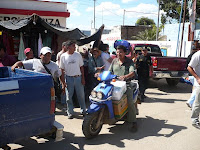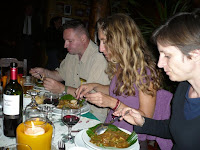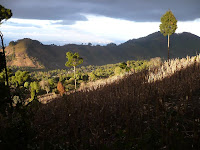 Like every other morning in San Cristobal, our day started at the Comedor Caminero. They were just a block or so from our hotel, and were always packed with people looking for the same thing as us: a tasty, cheap breakfast. They were so good we weren't even tempted to go anywhere else!
Like every other morning in San Cristobal, our day started at the Comedor Caminero. They were just a block or so from our hotel, and were always packed with people looking for the same thing as us: a tasty, cheap breakfast. They were so good we weren't even tempted to go anywhere else!We were off to spend the day on a tour. Yep, that's right, a tour. We're not tour people, but on the recommendation of a woman that we met, who had lived in San Cristobal for over 15 years, we did. Cesario
 was our tour guide, a man that had grown up in San Juan Chamula. Because of this, he was allowed to guide people in these towns, and was able to teach us what we were seeing, what the people believed, how they looked at outsiders, what they expected from US, and most importantly how we should behave, showing the proper respect to the people that lived there.
was our tour guide, a man that had grown up in San Juan Chamula. Because of this, he was allowed to guide people in these towns, and was able to teach us what we were seeing, what the people believed, how they looked at outsiders, what they expected from US, and most importantly how we should behave, showing the proper respect to the people that lived there.After meeting in town, we boarded a van and rode to San Juan Chamula. After getting out, we all gathered and listened to a little bit of Cesario's background information. He then led us up a hill that overlooked Chamula, spoke some more, and then led us down into the valley and past the cemetery, and then into the town's main square, where there was a market that day.



This was a local market, where the people in the surrounding communities came to sell their products and to buy food. Bags of grain were laid out,
 piles of wool shorn from the sheep, and all sorts of produce, both cultivated and collected from native plants and trees. In the picture on the left, a boy is showing me this bean sort of pod that he was selling. I'd seen them for sale several times and finally asked what it was. He held it out, pinched off one end and then peeled it open, revealing little green pea/beans inside. I asked him how people ate it, and he told me that it was eaten raw. He offered me some, so I tried it. It tasted awful.
piles of wool shorn from the sheep, and all sorts of produce, both cultivated and collected from native plants and trees. In the picture on the left, a boy is showing me this bean sort of pod that he was selling. I'd seen them for sale several times and finally asked what it was. He held it out, pinched off one end and then peeled it open, revealing little green pea/beans inside. I asked him how people ate it, and he told me that it was eaten raw. He offered me some, so I tried it. It tasted awful.He laughed at me. I told him I didn't like it and he laughed even harder. When I spit some out, I asked again how it was cooked, and he insisted that it was eaten raw. And then he laughed even harder.
 I told him that I didn't think so, and then his friend was laughing, too. I tried to get him to eat one, to 'show me' and he refused, laughing the entire time. It was a pretty good joke on the gringo, and I STILL don't know what they do with it. I _do_ know that it's not eaten raw, though!
I told him that I didn't think so, and then his friend was laughing, too. I tried to get him to eat one, to 'show me' and he refused, laughing the entire time. It was a pretty good joke on the gringo, and I STILL don't know what they do with it. I _do_ know that it's not eaten raw, though!One of the fascinating things that we learned about the local culture was about how they handle criminals. The local communities operate separate from the federal government, and handle things the way they have for centuries.
 When someone breaks a law, stealing for instance, they are locked up in the local jail, just a block from the market. In the picture, you can see the iron gate, which secures the single cell. The doorway on the left is the cell for women, which is slightly set back, to afford more privacy.
When someone breaks a law, stealing for instance, they are locked up in the local jail, just a block from the market. In the picture, you can see the iron gate, which secures the single cell. The doorway on the left is the cell for women, which is slightly set back, to afford more privacy.The 'criminal' is locked up for a few days and people are allowed to throw things at them and yell at them in any way. After the few days of public castigation, they are released and they then have to make amends, by paying for or replacing whatever was stolen. After that, they then have to serve the community for a period of time, the length of time depending on the severity of their 'crime.' If you look in the picture of the market above, you'll actually see three 'criminals' standing around. They have to wear certain clothes, the white ones you see in the picture, to indicate their status. They serve as the policemen! They're hanging around the market, walking around with their batons, patrolling the area. After their time is up, they go back to being just regular citizens again, and that's the end of it.
 One of their jobs is to make sure no one takes pictures of the local leaders. We were there on the day that they all sat in the town square in a semi-circle, available to the whole community. Anyone that had a complaint or a 'civil suit' could come and present their case before the leaders. If you click on the picture to the right, you can see them all sitting in the background. I wasn't about to take a picture, and discovered only later that they were in the background.
One of their jobs is to make sure no one takes pictures of the local leaders. We were there on the day that they all sat in the town square in a semi-circle, available to the whole community. Anyone that had a complaint or a 'civil suit' could come and present their case before the leaders. If you click on the picture to the right, you can see them all sitting in the background. I wasn't about to take a picture, and discovered only later that they were in the background. In the market, Cesario introduced us to two old ladies that both were there every market day. They used wool from their sheep to make yarn, which they then wove into shawls and other items. They were both deaf and mute, and the lady in the picture to the left helped translate. They were both quite proud of their handiwork, and were happy to demonstrate how they spun their yarn by hand, with what looked like a small wooden knitting needle that they spun on the ground, turning a combed wad of wool into the yarn.
In the market, Cesario introduced us to two old ladies that both were there every market day. They used wool from their sheep to make yarn, which they then wove into shawls and other items. They were both deaf and mute, and the lady in the picture to the left helped translate. They were both quite proud of their handiwork, and were happy to demonstrate how they spun their yarn by hand, with what looked like a small wooden knitting needle that they spun on the ground, turning a combed wad of wool into the yarn. We took a picture of them both, holding up a few of the things that they made, which we bought. The shawl on the right kept Susan warm for our entire trip! The weather was much colder than we were prepared for, so adding some local shawls and sweaters to our backpacks was necessary.
We took a picture of them both, holding up a few of the things that they made, which we bought. The shawl on the right kept Susan warm for our entire trip! The weather was much colder than we were prepared for, so adding some local shawls and sweaters to our backpacks was necessary.One of the highlights of our trip was visiting the local church. This was a Mayan church, nominally Catholic. Inside there were no pews, no priest and no collection plate. Pine needles were strewn all over the floor, and people that were there to worship would just clear a space on the tiled floor and sit down. They lit candles, had bottles of
 liquor, bottles of soda and although we didn't see any when we were inside, chickens and eggs often appear.
liquor, bottles of soda and although we didn't see any when we were inside, chickens and eggs often appear.Inside, we carefully walked through, smelling the pine needles and incense, keeping a respectful distance from others, soaking it all in. Cesario impressed upon us the independence of the people, how they had continued their Mayan traditions and manner of worship even after being 'converted' by the Spanish priests. It was certainly different than any other church we'd seen, with people of all ages sprawled along the edges, talking quietly with each other, sitting silently, praying or chanting. Candles were scattered in groups, some attended and some left to burn by themselves. Some people were quite fervent, but most were quietly enjoying the sun shining through the high windows, the sounds of thankful people, and the smell of pine.
 Arriving in Zinacantán, we made our way to a family´s home, where they worked and (of course) also offered their products for sale.
Arriving in Zinacantán, we made our way to a family´s home, where they worked and (of course) also offered their products for sale.Cesario took the opportunity to now explain some of the things we´d seen in the church in Chamula. He passed around a sample of the "posh" that we´d seen, which is sort of like a rum concoction, with herbs. It tasted pretty good!
He also explained the purpose of the different colors of the candles, and also the reason why Coca-Cola, Fanta Strawberry, Fanta Orange and Sprite are used in the rituals. The color of the candles matches the colors of the soda, and each means the same thing. The white stands for tortillas, or bread. In times past, pre-soda days, chicha would have been used, which was also bubbly!
 I´ll post more details on this later.
I´ll post more details on this later.The mother of the family demonstrated her backstrap loom for us, and we got to see one of her daughters preparing the long strands of thread for the next weaving. After a bit of that, she went into their kitchen, where the other girls had started a fire, and they all prepared some homemade tortillas.
They soak the corn with lime, which softens the kernel, and then it´s ground by hand with a mortar and pestle type grinder, and then the masa, the paste, is formed by hand into the flat tortilla. Then they toast it over the fire, which you can see below.



They had a bowl of ground, toasted pumpkin seeds, which we could put on the tortilla, and then roll it all up and eat it. I did.
 Of course, when we were leaving, many if not all of us did buy some of their wares, and gladly so. This family was nowhere near the poorest in the community, and with so many mouths to feed in their family, it was wonderful to see them doing so well.
Of course, when we were leaving, many if not all of us did buy some of their wares, and gladly so. This family was nowhere near the poorest in the community, and with so many mouths to feed in their family, it was wonderful to see them doing so well.The sunflower type designs that you see in the picture is their handiwork, and while this is the town where they make this design, you can see it in markets for miles and miles all around the area.
 After leaving the house, we continued to walk for a few minutes toward the center of town. When we arrived in the town square, the market had already closed for the day. It was very windy the day that we visited, and although it was sunny and mostly clear, being up at a higher altitude made it pleasantly brisk.
After leaving the house, we continued to walk for a few minutes toward the center of town. When we arrived in the town square, the market had already closed for the day. It was very windy the day that we visited, and although it was sunny and mostly clear, being up at a higher altitude made it pleasantly brisk.The last of the people were cleaning up, packing their things and getting ready to head back into the small hamlets that surround the main town. The people in the two different communities have a different style of dress, so before continuing on, Cesario took the opportunity to point out how people from each community will have stalls in the other on market days.
 Before continuing into the church, Cesario explained more about the differences between the two communites. He constantly impressed upon us that each of the two communities had very different ways of dress, and also ways of worship. Whereas in the last church in Chamula, there were chickens, eggs, liquor and Coca-cola, inside this church you wouldn´t find anything like that.
Before continuing into the church, Cesario explained more about the differences between the two communites. He constantly impressed upon us that each of the two communities had very different ways of dress, and also ways of worship. Whereas in the last church in Chamula, there were chickens, eggs, liquor and Coca-cola, inside this church you wouldn´t find anything like that.Indeed, upon entering, there was a service being performed, which you might have seen inside any give church on any given day, anywhere in Mexico. The people were orderly sitting in the pews, quietly listening to the priest. We didn´t linger inside, but just looked around a bit and then left.
























 It seemed that everywhere you turned there was a beautiful picture just waiting for you to come along and take it. Not just Susan, but the volcano, too. : ) She was taking almost all of the pictures in this batch, so she´s not in many of them.
It seemed that everywhere you turned there was a beautiful picture just waiting for you to come along and take it. Not just Susan, but the volcano, too. : ) She was taking almost all of the pictures in this batch, so she´s not in many of them.














